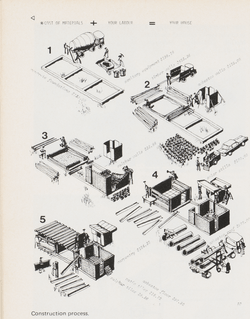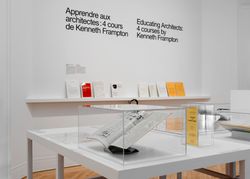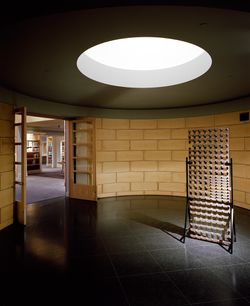Project
AP075.S1.1994.PR01
Description:
Project series documents Cornelia Hahn Oberlander's project of a roof garden for the New Canadian Embassy at Leipziger Platz in Berlin, Germany. Oberlander worked on this project in from 1999-2005 with architectural firm Kuwabara, Payne, McKenna, Blumberg Architects. Oberlander's work for the project included a terrace at the Ambassador's Level (6th floor) with mounded evergreen white flowering groundcover azaleas, cascading roses hanging along the Leipzigerstrasse facade, and a green roof on top of the building. The concept of the landscaping of the green roof was to represente Canada's land of the north in an abstract form, simulating the river system of the MacKenzie River in the Northwest Territories, linking Alberta to the Arctic Ocean. She used black-glass panels to represente the water. The drainage for the green roof was also connected the drainage infrastructure of the building to recycle the water collected from the roof. The project series includes sketches and design development drawings for the green roof landscaping, planting details and irrigation details, presentation drawings from KPMB and drawings of the building used as reference. The project is also documented through research material, concept notes by Oberlander, correspondence, including with architects, consultants, contractors and clients, proposal, specifications, and press clippings about the project. The project series also includes sample of glass tiles used for the landscaping.
1994-2005
New Canadian Embassy in Berlin, Germany (1994-2005)
Actions:
AP075.S1.1994.PR01
Description:
Project series documents Cornelia Hahn Oberlander's project of a roof garden for the New Canadian Embassy at Leipziger Platz in Berlin, Germany. Oberlander worked on this project in from 1999-2005 with architectural firm Kuwabara, Payne, McKenna, Blumberg Architects. Oberlander's work for the project included a terrace at the Ambassador's Level (6th floor) with mounded evergreen white flowering groundcover azaleas, cascading roses hanging along the Leipzigerstrasse facade, and a green roof on top of the building. The concept of the landscaping of the green roof was to represente Canada's land of the north in an abstract form, simulating the river system of the MacKenzie River in the Northwest Territories, linking Alberta to the Arctic Ocean. She used black-glass panels to represente the water. The drainage for the green roof was also connected the drainage infrastructure of the building to recycle the water collected from the roof. The project series includes sketches and design development drawings for the green roof landscaping, planting details and irrigation details, presentation drawings from KPMB and drawings of the building used as reference. The project is also documented through research material, concept notes by Oberlander, correspondence, including with architects, consultants, contractors and clients, proposal, specifications, and press clippings about the project. The project series also includes sample of glass tiles used for the landscaping.
Project
1994-2005
The Toolkit for Today seminar is a constitutive part of the CCA Doctoral Students Program. We invite scholars to open up their toolboxes, share methodological challenges and approaches, and discuss the key concepts they work with on contemporary issues in architecture and related disciplines. In 2016, the Toolkit for Today focuses on “Keywords for the Environment,”(...)
27 June 2016 to 30 June 2016
Toolkit for Today: Keywords for the Environment
Actions:
Description:
The Toolkit for Today seminar is a constitutive part of the CCA Doctoral Students Program. We invite scholars to open up their toolboxes, share methodological challenges and approaches, and discuss the key concepts they work with on contemporary issues in architecture and related disciplines. In 2016, the Toolkit for Today focuses on “Keywords for the Environment,”(...)
The three recipients of this years Power Corporation of Canada Award, Lisa Chow (McGill University), Michèle Curtis (Carleton University), and Geneviève Depelteau (University of British Columbia), present the findings of their three-month research residency at the CCA, during which they studied the rise of an environmental consciousness in architecture and landscape(...)
Shaughnessy House
1 September 2016, 6pm
Is the Problem... Still the Environment?
Actions:
Description:
The three recipients of this years Power Corporation of Canada Award, Lisa Chow (McGill University), Michèle Curtis (Carleton University), and Geneviève Depelteau (University of British Columbia), present the findings of their three-month research residency at the CCA, during which they studied the rise of an environmental consciousness in architecture and landscape(...)
Shaughnessy House
Project
AP056.S1.1995.PR02
Description:
This project series documents the Providence Healthcare Centre in Scarborough, Ontario from 1995-2000. The office identified the project number as 9504. This project, headed by Marianne McKenna in joint-venture with Montgomery and Sisam Architects, consisted of a long-term care facility on the Healthcare Centre campus located at the corner of St. Clair East and Warden Avenues. The facility diverged from the traditional institutional model to house 288 residents in a more residential setting. Bay windows, porches and chimneys were borrowed from residential architecture to contribute to this effect. The "houses," accommodating 18 residents each, were four-storeys high and arranged in two L-shaped wings with landscaped gardens in their interior courtyards. A double-height Great Hall joined the two volumes at the building's centre, which was built to house a variety of social and recreational activities for the residents. A chapel, hair salon, café and general store were also included. The project was also known as the Cardinal Ambrozic Houses of Providence. The project is recorded through drawings and presentation watercolour paintings dating from 1995-1999. The drawings are mostly originals and include a large number of sketches along with presentation renderings, plans, elevations, sections, perspectives and details.
Providence Healthcare Centre, Scarborough, Ontario (1995-2000)
Actions:
AP056.S1.1995.PR02
Description:
This project series documents the Providence Healthcare Centre in Scarborough, Ontario from 1995-2000. The office identified the project number as 9504. This project, headed by Marianne McKenna in joint-venture with Montgomery and Sisam Architects, consisted of a long-term care facility on the Healthcare Centre campus located at the corner of St. Clair East and Warden Avenues. The facility diverged from the traditional institutional model to house 288 residents in a more residential setting. Bay windows, porches and chimneys were borrowed from residential architecture to contribute to this effect. The "houses," accommodating 18 residents each, were four-storeys high and arranged in two L-shaped wings with landscaped gardens in their interior courtyards. A double-height Great Hall joined the two volumes at the building's centre, which was built to house a variety of social and recreational activities for the residents. A chapel, hair salon, café and general store were also included. The project was also known as the Cardinal Ambrozic Houses of Providence. The project is recorded through drawings and presentation watercolour paintings dating from 1995-1999. The drawings are mostly originals and include a large number of sketches along with presentation renderings, plans, elevations, sections, perspectives and details.
Project
archives
Level of archival description:
Fonds
AP189
Synopsis:
L’installation Météorologie d’intérieur fut présentée au Centre Canadien d’Architecture (CCA) lors de l’exposition Environ(ne)ment (18 octobre 2006-10 juin 2007) et à Rovereto en Italie lors de l’exposition Manifesta 7 (19 juillet-2 novembre 2008). Les documents d’archives de l’installation comprennent le logiciel développé pour l’installation et une sélection des objets installés dans les deux espaces d’exposition. *** The installation Interior Weather was presented at the Candian Centre for Architecture (CCA) as part of the exhibition Environ(ne)ment (October 18, 2006-June 10, 2007) and in Rovereto, Italy as part of Manifesta 7 (July 19-November 2, 2008). The records of the installation Interior Weather include the software developed for the installation and a selection of objects installed in the exhibition spaces.
2000-2008
Philippe Rahm "Interior Weather" installation records
Actions:
AP189
Synopsis:
L’installation Météorologie d’intérieur fut présentée au Centre Canadien d’Architecture (CCA) lors de l’exposition Environ(ne)ment (18 octobre 2006-10 juin 2007) et à Rovereto en Italie lors de l’exposition Manifesta 7 (19 juillet-2 novembre 2008). Les documents d’archives de l’installation comprennent le logiciel développé pour l’installation et une sélection des objets installés dans les deux espaces d’exposition. *** The installation Interior Weather was presented at the Candian Centre for Architecture (CCA) as part of the exhibition Environ(ne)ment (October 18, 2006-June 10, 2007) and in Rovereto, Italy as part of Manifesta 7 (July 19-November 2, 2008). The records of the installation Interior Weather include the software developed for the installation and a selection of objects installed in the exhibition spaces.
archives
Level of archival description:
Fonds
2000-2008
Amid education reform in American schools of architecture in the 1970s, Kenneth Frampton was integral in transforming the curriculum of Columbia University’s Graduate School of Architecture Planning. In particular, he designed and taught what became three core courses: the theory seminar “Comparative Critical Analysis,” the history lectures “Thresholds of Modern(...)
31 May 2017 to 24 September 2017
Educating Architects: Four Courses by Kenneth Frampton
Actions:
Description:
Amid education reform in American schools of architecture in the 1970s, Kenneth Frampton was integral in transforming the curriculum of Columbia University’s Graduate School of Architecture Planning. In particular, he designed and taught what became three core courses: the theory seminar “Comparative Critical Analysis,” the history lectures “Thresholds of Modern(...)
Series
Dessins et tableaux
AP104.S1
Description:
Series I consists of sketches, drawings and paintings, mostly created by Parizeau. From the period he spent in Europe (1923-1933), there are 11 student drawings in the standard presentation format of the École des Beaux-arts de Paris, a volume of course notes, as well as unidentified drawings, sketchbooks and paintings of primarily buildings and landscapes executed in Paris and during his travels in France. Drawings relating to Parizeau's architectural career in Montreal are represented in a number of independant projects, including a small chapel beside the St. Lawrence River, a pair of two-storey cabin-cottages outside of Montreal, and several residences in the city. The documents are mostly original preliminary studies with some reproductions of working drawings. It should be noted that there are also photographs of exterior details of the Laroque Residence and the Jarry Residence in documents CO2 in Series II. Reproductions of designs for worker housing by French architect Eugène Beaudoin in 1938 perhaps give a clue to Parizeau's relatively early employment of modernist forms. A residence in Baie D'Urfé is unlikely to be connected to Parizeau because its date, ca. 1955, is a decade after his death. Parizeau's concern with furniture and interior design is represented in the Archive with many lively perspective sketches in colour, and elevation and plan studies of several kinds of rooms and types of furniture. Some preliminary drawings for interiors were grouped with the Gillow house in Ville Mont-Royal, and the Walter Downs Residence in Montreal. The artworks by Parizeau consist of paintings and drawings of landscapes, buildings, still lifes and figure studies on loose sheets and in bound sketchbooks. These works are executed in a variety of media, including pencil, coloured pencil, watercolour on paper, and oil paint on masonite panels. Studies of buildings in Brittany and Paris are the subjects in three small sketchbooks, while larger spiral-bound drawing books contain some architectural plans, elevations and details. Most of these artworks and sketches were likely created in Europe before 1933.
1917-1955
Dessins et tableaux
Actions:
AP104.S1
Description:
Series I consists of sketches, drawings and paintings, mostly created by Parizeau. From the period he spent in Europe (1923-1933), there are 11 student drawings in the standard presentation format of the École des Beaux-arts de Paris, a volume of course notes, as well as unidentified drawings, sketchbooks and paintings of primarily buildings and landscapes executed in Paris and during his travels in France. Drawings relating to Parizeau's architectural career in Montreal are represented in a number of independant projects, including a small chapel beside the St. Lawrence River, a pair of two-storey cabin-cottages outside of Montreal, and several residences in the city. The documents are mostly original preliminary studies with some reproductions of working drawings. It should be noted that there are also photographs of exterior details of the Laroque Residence and the Jarry Residence in documents CO2 in Series II. Reproductions of designs for worker housing by French architect Eugène Beaudoin in 1938 perhaps give a clue to Parizeau's relatively early employment of modernist forms. A residence in Baie D'Urfé is unlikely to be connected to Parizeau because its date, ca. 1955, is a decade after his death. Parizeau's concern with furniture and interior design is represented in the Archive with many lively perspective sketches in colour, and elevation and plan studies of several kinds of rooms and types of furniture. Some preliminary drawings for interiors were grouped with the Gillow house in Ville Mont-Royal, and the Walter Downs Residence in Montreal. The artworks by Parizeau consist of paintings and drawings of landscapes, buildings, still lifes and figure studies on loose sheets and in bound sketchbooks. These works are executed in a variety of media, including pencil, coloured pencil, watercolour on paper, and oil paint on masonite panels. Studies of buildings in Brittany and Paris are the subjects in three small sketchbooks, while larger spiral-bound drawing books contain some architectural plans, elevations and details. Most of these artworks and sketches were likely created in Europe before 1933.
Série 1
1917-1955
Project
Westpen
AP144.S2.D101
Description:
File documents an unexecuted project for Westpen, an animal enclosure for the property at West Green House at Hartley Wintney, in Hampshire, England, and also the location for the project Greenbird (AP144.S2.D96). The pen can be adapted for several uses and its pivoting and sliding gates can be removed when not used for livestock, to be converted into a sculptured landscape for picnicking and leisure activities. Conceptual drawings include diagrammatic sketches which show the movement of animals through the pen for collecting, weighing, cleaning, and shearing. Sketches show pivoting rails, and preliminary plans are annotated with individual gate dimensions. Design development and working drawings illustrate the development of the pen components: 8 ft swing slide and cattle gates; 3 ft sheep gates; a sheep dip and footbath area; a sheep drafting and guillotine gate; and feed bins. Plans and details show the concrete apron and pre-formed gate sockets. Reprographic copies made from a consultant's drawings show the configuration of gates and hurdles. Some material in this file was published in Price-Works II' (London: Architectural Press, 1984), 72, 79. Material in this file was produced between 1977 and 1979. File contains conceptual drawings, design development drawings, model, photographic materials and textual records.
1977-1979
Westpen
Actions:
AP144.S2.D101
Description:
File documents an unexecuted project for Westpen, an animal enclosure for the property at West Green House at Hartley Wintney, in Hampshire, England, and also the location for the project Greenbird (AP144.S2.D96). The pen can be adapted for several uses and its pivoting and sliding gates can be removed when not used for livestock, to be converted into a sculptured landscape for picnicking and leisure activities. Conceptual drawings include diagrammatic sketches which show the movement of animals through the pen for collecting, weighing, cleaning, and shearing. Sketches show pivoting rails, and preliminary plans are annotated with individual gate dimensions. Design development and working drawings illustrate the development of the pen components: 8 ft swing slide and cattle gates; 3 ft sheep gates; a sheep dip and footbath area; a sheep drafting and guillotine gate; and feed bins. Plans and details show the concrete apron and pre-formed gate sockets. Reprographic copies made from a consultant's drawings show the configuration of gates and hurdles. Some material in this file was published in Price-Works II' (London: Architectural Press, 1984), 72, 79. Material in this file was produced between 1977 and 1979. File contains conceptual drawings, design development drawings, model, photographic materials and textual records.
File 101
1977-1979
The Idea of the Penitentiary
This exhibition explores the notion of penitentiary, which worked its way into the consciousness and across the landscape of Europe and North America during the nineteenth century. Drawing upon the growing rationalist tendencies in architecture and social theory during the eighteenth century, proponents of penitentiary emphasised a clear geometry of separation,(...)
Hall cases
8 November 1995 to 31 May 1996
The Idea of the Penitentiary
Actions:
Description:
This exhibition explores the notion of penitentiary, which worked its way into the consciousness and across the landscape of Europe and North America during the nineteenth century. Drawing upon the growing rationalist tendencies in architecture and social theory during the eighteenth century, proponents of penitentiary emphasised a clear geometry of separation,(...)
Hall cases
archives
Level of archival description:
Fonds
Bernard Cache fonds
AP169
Synopsis:
Bernard Cache, fonds, 1991-2011, document the development and design process for the Objectile firm and its decorative panels and furniture. The records focus mostly on daily activities of the firm, the collaboration of principal Bernard Cache with TopSolid software, and his parallel academic work. The records consist solely of original born-digital material.
1992-2011
Bernard Cache fonds
Actions:
AP169
Synopsis:
Bernard Cache, fonds, 1991-2011, document the development and design process for the Objectile firm and its decorative panels and furniture. The records focus mostly on daily activities of the firm, the collaboration of principal Bernard Cache with TopSolid software, and his parallel academic work. The records consist solely of original born-digital material.
archives
Level of archival description:
Fonds
1992-2011



